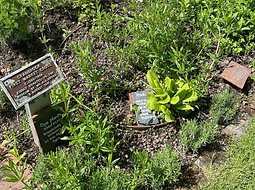top of page
Polly Bennett

Took a trip to one of my favourite local places: Cranbrook Museum, and I happened upon their Dye Garden, which I hadn’t seen before. It centres around the dyes that would have been used in the Medieval Broadcloth Industry; madder, woad and weld.
June 2023
After a conversation with Sue Huxley, the museum's owner and fellow dye-lover, she very kindly gifted me a couple madder and woad plants to see if I can reproduce the Broadcloth colours!





🤞🏻
An example of
Broadcloth wool

Mum showed me how to cut the roots of the madder in half - thought I would hurt the plant but it’s actually v simple.
One half of the madder plant, I replanted, and the other half I harvested the roots from to extract the madder dye/pigment! There were lots of little madder shoots, which I planted too, along with the woad.



Madder root all nice n clean





Madder pigment drying out in the sun before I grind it down into powder.
Grinding madder root in water and leaving to soak overnight
Next day, adding solutions of alum, and then soda ash, resulting in a fizzy chemical reaction that sits overnight
Filtering the madder pigment (the liquid can be used as a stain or a dye)

Once I cleaned and dried my madder root, I cut it up into tiny pieces to use for TWO processes; extracting pigment and dyeing.
MADDER PIGMENT EXTRACTION



MADDER DYEING
Using madder dye I dyed various fibres...
Madder-dyed wool - just the same as in the Broadcloth industry
Bought a linen shirt from Vinted, altered it and dyed it with madder
WOAD DYEING / EXTRACTION

Madder-dyed cotton and wool

To extract woad dye, you collect as many leaves from the plant as possible and use soda ash to extract the pigment and sodium dithionite for dyeing.
I use Teresinha Robert's method.
Keep the seeds for more plants, and because they themselves create a wonderful pink dye!


Soaking the leaves
Aerating the vat

Fascinating seeing the difference in colour, depending on the fibre

The five core dye colours used in the Broadcloth industry were:
1. Madder (root) = red
2. Woad (leaf) = blue
3. Weld (leaf) = yellow
4. Weld and woad = Lincoln green
5. Oak galls = black/grey
The dye garden is currently out of weld.


Oak gall-dyed wool
Oak gall-dyed wool and cotton


Pigments extracted so far...

18th June 2023
I displayed my findings (so far) at the museum for Cranbrook's Garden Safari.


Using carding brushes to separate individual fibres into lying parallel to one another, while also removing most of the impurities.
Carding my oak gall-dyed wool, in my madder-dyed waistcoat.
Lots of reading to be done!

I am using Bionic Reading - traditionally used by neurodivergent folk, or more specifically people with ADHD, and those with reading difficulties - created by Swiss typographic designer Renato Casutt. It bolds a small number of letters at the beginning of a word allowing your memory to fill in the rest, creating a more visually stimulating font.
bottom of page